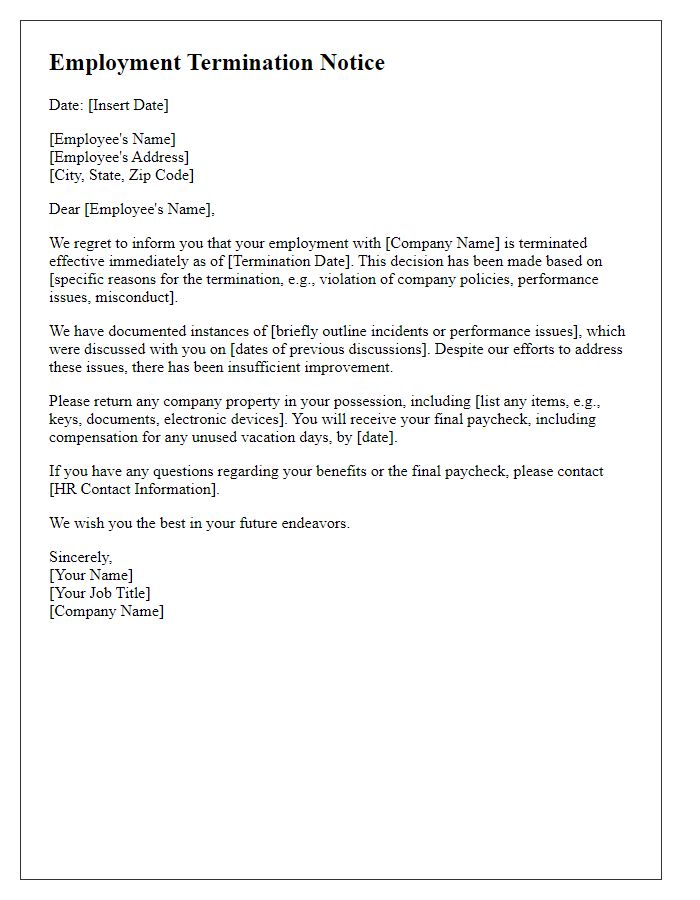When it comes to writing an employment termination notice, clarity and professionalism are key. This letter serves as an official communication to convey the difficult decision of ending someone's employment, so it's important to approach the topic with empathy and respect. In this article, we will break down the essential components of an effective termination letter, ensuring that both the employer's intentions and the employee's dignity are preserved. Let's dive in and explore best practices for crafting a termination notice that meets legal requirements while maintaining a respectful tone.

Clear subject line
Employment Termination Notice: [Employee Name] - [Position] - [Effective Date] In accordance with company policy, this notice formally communicates the termination of employment for [Employee Name], who has held the position of [Position] since [Start Date]. The effective termination date will be [Effective Date]. Reasons for this decision include [specific reasons for termination, e.g., performance issues, policy violations, etc.]. Prior discussions and documentation of these issues have been provided to ensure transparency. Employees are encouraged to review their final pay details and any benefits that may be affected. The HR department is available for any questions or further clarifications regarding the termination process.
Specific termination date
The employment termination notice outlines the cessation of an employee's contract, specifying the date on which the employment will officially end. This document is crucial for ensuring clarity between the employer and employee regarding expectations and final work responsibilities. The notice typically includes key details such as the employee's name, position, and the specific termination date, which may range from immediate to a two-week notice period. Legal considerations, such as adherence to local labor laws and company policies, must also be addressed to avoid potential disputes or misunderstandings. Final paychecks, benefits, and the process for returning company property are also essential components of this communication.
Reason for termination
Termination of employment due to performance issues often stems from inadequate job execution, consistent tardiness, or failure to meet established goals. Documented incidents, such as missed deadlines or unsatisfactory performance reviews, can substantiate the reasoning. Employers, adhering to company policy, typically communicate these concerns verbally and in written form, ensuring that employees understand the basis for their termination. This process may also include references to specific incidents, dates, and previous warnings given, establishing a clear timeline of events leading to the decision. Additionally, the termination notice should outline the next steps regarding final pay, benefits, and return of company property, as governed by local labor laws.
Benefits and final paycheck details
Termination of employment often involves providing crucial information about benefits and final paycheck details. Employees should receive a comprehensive explanation of their benefits, including health insurance termination dates, eligibility for COBRA (Consolidated Omnibus Budget Reconciliation Act) continuation coverage, and retirement plan options. Details on unused vacation or paid time off (PTO) payouts should also be included in the notice. Furthermore, outlining the timeline for the final paycheck, which may include any outstanding wages, bonuses, or commissions, helps ensure clarity. This final paycheck may be subject to state laws regarding the timing of release, emphasizing the importance of adhering to specific regulations, such as California's 72-hour rule, for timely compensation post-termination. Providing this information fosters transparency and aids in smooth transition for the employee.
Contact information for questions
When an employment termination notice is issued, it is crucial to provide clear contact information for any questions or concerns related to the termination process. Detailed contact information should include the name of the HR representative or manager overseeing the process, direct phone number (such as a work phone) for immediate queries, and an official email address (such as hr@company.com) for further written communication. This information ensures that the affected employee can easily reach out for clarification or assistance regarding their final paycheck, benefits, or any other employment-related inquiries. Additionally, providing a specific timeframe for responses (like 24 to 48 hours) can help manage expectations and ensure timely communication.
Letter Template For Employment Termination Notice Samples
Letter template of employment termination notice - voluntary resignation













Comments